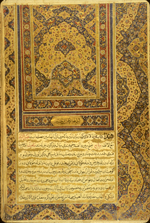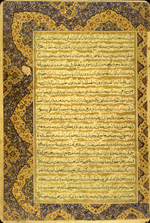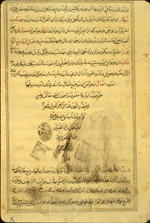Catalogue: Pharmaceutics
-
 Makhzan al-adviyah (MS P 12)
Makhzan al-adviyah (MS P 12) - (The Storehouse of Medicaments)
- مخزن الادوية
- probably from Jāmi‘ al-javāmi‘-i Muḥammad-Shāhī
- (The Compendium of Summaries for Muhammad Shah)
- جامع الجوامع محمد شاهى
- by Ḥakīm Muḥammad Hāshim ibn Ḥakīm Muḥammad Hādī Qalandar ibn Muzaffar al-Dīn ‘Alavī Shīrāzī ‘Alavī Khān (d. 1747/1160 or 1749/1162)
- حكيم محمد هاشم ابن حكيم محمد هادى قلندر ابن مظفر الدين علوى شيرازى علوى خان نواب معتمد الملوك
The Jāmi‘ al-javāmi‘-i Muḥammad-Shāhī was a large pharmacopoeia of at least several volumes or fascicules (juz').The treatise was dedicated to and named for Muḥammad-Shāh (reg.1719-1748), the Mughal ruler in Delhi who had raised ‘Alavī Khān to the rank of Shash-hazari and given him the title of Mu‘tamad al-Muluk. For Muḥammad-Shāh, see C.E. Bosworth, 'Muhammad Shah', EI (2nd ed.), vol. 7, p. 457.
NLM has one fascicle of a beautifully illuminated copy of the alphabetical study of material medica. The copy was prepared as a presentation copy to an unnamed patron. It is possible that this copy was part of the presentation copy made for Muḥammad-Shāh, since the copy was completed on 4 Dhu al-Hijjah 1144 (= 3 May 1732) during the reign of Muḥammad-Shāh and during the lifetime of the author. This fascicle contains only a portion of the section on material medica presented in alphabetical order, beginning with the letter sin.
The treatise by ‘Alavī Khān titled Jāmi‘ al-javāmi‘-i Muḥammad-Shāhī was used as the basis of a later treatise written in 1771/1185 titled Majma‘ al-javāmi‘ va-zakhā’ir al-tarākīb (The Assemblage of Generalities and Treasuries of Compounds) by ‘Alavī Khān's great-nephew Muḥammad Ḥusayn ibn Muḥammad Hādī al-‘Aqīlī al-‘Alavī al-Khurasānī al-Shīrāzī, known as Hakīm Muḥammad Hādīkhān See NLM MS P 11.1 for a copy of the latter.
Only two other copies of Jāmi‘ al-javāmi‘-i Muḥammad-Shāhī are recorded, and the only accessible one is fragmentary and incomplete. Because of this, it has not been possible to confirm that the section reproduced in NLM MS P 12 under the title Makhzan al-adviyah (with no author given) is in fact extracted from Jāmi‘ al-javāmi‘-i Muḥammad-Shāhī. However, most of the material appears to be incorporated in one way or another into the Majma‘ al-javāmi‘ va-zakhā’ir al-tarākīb by his great-nephew, and since the latter composition is known to have been based upon that of his great-uncle, it is reasonable to assume that NLM MS P 12 represents a portion of ‘Alavī Khān's Jāmi‘ al-javāmi‘-i Muḥammad-Shāhī. For the only two recorded copies of ‘Alavī Khān's Jāmi‘ al-javāmi‘-i Muḥammad-Shāhī, one of which is at Oxford (Bodleian MS Pers.d.99), see Storey PL II,2, p. 274, no. 475(1).
Moreover, this particular portion of the treatise by ‘Alavī Khān is in fact reproduced verbatim by his great-nephew under a slightly fuller title (Makhzan al-adviyah va tadhkirat uli al-nuha). In the introduction to the latter treatise, the great-nephew states that he, Muḥammad Ḥusayn ibn Muḥammad Hādīkhān, composed the treatise after he completed his Assemblage of Generalities and Treasuries of Compounds in 1771. He goes on to name 9 sources he employed in preparing his treatise, one of which was the material medica (mufradat) of his grand-uncle, whom he called by his title: Mu‘tamad al-Muluk Sayyid ‘Alavikhan. Yet, a comparison of the text in MS P 12 - a presentation copy made in 1732 (1144 H) - with the treatise supposedly written after 1771 by Muḥammad Hādīkhān, reveals that the portion of the great-nephew's treatise concerned with the alphabetical presentation of material medica is absolutely identical, word for word, to that in MS P 12.
For this purpose, comparison was made between NLM MS P 12 and a manuscript now in the British Library of the great-nephew's Makhzan al-adviyah va tadhkirat uli al-nuha, OIOC MS I.O. Islamic 1398 (Ethé no. 2362, copy completed in 1779/1193), where it was found that the complete text of MS P 12 is precisely equivalent to that on fol. 164a, line 16, to fols. 304a, line 13 in the British Library manuscript, the only difference being that the in British Library manuscript, at the end of the section, the date Jumadá� II 1190 [= June-July 1776] is given. The text in NLM MS P 12 also corresponds to the latter portion of a lithographed text in which the author's name is given as MuḥammadḤusayn ibn Muḥammad Hādī al-‘Aqili al-‘Alavi known as Hakīm Muḥammad Hādīkhān; for the lithographed text, see Muhammad Ḥusayn Khan, Makhzam al-adwiyah, with in the margins Tuhfat al-mu'minin by Muḥammad Mu’min, Delhi : Muhammadi Press, 1868, where the text beginning at p.333 corresponds to the manuscript here catalogued, and the lithographed text, Muḥammad Ḥusayn, Makhzan al-adwiyah, Calcutta?, 1832, where the text beginning at p.465 corresponds to this manuscript.
Therefore, because the present manuscript (MS P 12) was completed as a presentation copy in 1732, during the reign of Muḥammad-Shāh to whom ‘Alavī Khān dedicated his Jāmi‘ al-javāmi‘-i Muḥammad-Shāhī - some 40 years before Muḥammad Hādīkhān supposedly wrote his treatise of a similar title - it is reasonable to assume that the present work (which lacks an author's name) was actually composed by the grand-uncle (‘Alavī Khān) only to be later appropriated by the great-nephew Muḥammad Hādīkhān.
Makhzan al-adviyah (MS P 12))
Illustrations
The right-hand side of an illuminated double-opening that begins one fascicle of a presentation copy of a pharmacopoeia apparently taken from the Jāmi‘ al-javāmi‘-i Muḥammad-Shāhī by Hakīm ‘Alavī Khān (d. 1747/1160 or 1749/1162), which was dedicated to and named for the Mughal emperor Muḥammad-Shāh. The copy was completed on 4 Dhu al-Hijjah 1144 (= 3 May 1732) by Ḥusayn ibn ‘Abd al-[ ? ] Mūsavī during the reign of Muḥammad-Shāh, and it may have formed part of the presentation copy to him. Above the text, which is written inside gilt cloud-bands set within a gilt and black frame, there is a large illuminated head-piece painted in gilt, red, blue, and pink opaque watercolors incorporating very small floral designs. The margins are filled with similar decorative panels painted in blue, red, pink, brown, and gilt. The marginal illumination extends also to the facing folio (see fol. 2a illus).
The left-hand side of an illuminated double-opening that begins one fascicle of a presentation copy of a pharmacopoeia apparently taken from the Jāmi‘ al-javāmi‘-i Muḥammad-Shāhī by Hakim ‘Alavī Khān (d. 1747/1160 or 1749/1162), which was dedicated to and named for the Mughal emperor Muḥammad-Shāh. The copy was completed on 4 Dhu al-Hijjah 1144 (= 3 May 1732) by Ḥusayn ibn ‘Abd al-[ ? ] Mūsavī during the reign of Muḥammad-Shāh, and it may have formed part of the presentation copy to him. The text is written inside gilt cloud-bands set within a gilt and black frame. The margins are filled with decorative panels incorporating very small floral designs, painted in blue, red, pink, brown, and gilt. The marginal illumination extends also to the facing folio (see fol. 1b illus).
The last folio of a presentation copy of one fascicle, concerned with medicaments discussed in alphabetical order, of a pharmacopoeia. It appears to be a copy of a portion of the Jāmi‘ al-javāmi‘-i Muḥammad-Shāhī by Hakīm ‘Alavī Khān (d. 1747/1160 or 1749/1162), which was dedicated to and named for the Mughal emperor Muḥammad-Shāh. The copy was completed on 4 Dhu al-Hijjah 1144 (= 3 May 1732) by Ḥusayn ibn ‘Abd al-[ ? ] Mūsavī during the reign of Muḥammad-Shāh, and it may have formed part of the presentation copy to him. There are impressions of three large owner's stamps, one oval and two square, not very legible.
Physical Description
Persian. 426 leaves (fols. 1b-426b). Dimensions 29.8 x 20.2 (text area 21.2 x 12.3) cm; 19 lines per page. The title Kitab Makhzan al-adviyah is taken from the start of the text, fol. 1b, though it would appear to be a subtitle and not the title of the treatise of which this volume forms one fascicle. No author is given.
The date of the copy 4 Dhu al-Hijjah 1144 (= 3 May 1732) is given in the colophon (fol. 426b), where the scribe's name is given as: Ḥusayn ibn ‘Abd al-[?] Mūsavī. This name may have been written over an earlier one.
This copy contains the second part of an alphabetical study of materia medica, beginning with the letter sin.
The text is written in a fine medium-large professional naskh with some vocalization using black ink with headings in red. There are red overlinings and red marginal headings. There are also catchwords, The entire text is written within frames of gilt fine blue lines filled with gilt.
Fol 1b has an large illuminated head-piece in red, blue, and gilt; on fols. 1b and 2a the text is written within gilt cloud-bands and is set within a gilt and black frame, while the areas outside the frame are filled with abstract ornamentation of blue, red, and gilt; on all other folios the text is written within a frame of gilt, blue, and black, which is set within a larger frame formed of two delicate black lines, partially gilt filled.
The ivory paper is thin and very glossy; with laid lines, single chain lines and watermarks. There is some water damage and soiling through thumbing. There are repairs to the edges of the first two folios which are now guarded. A tissue has been placed between the first two folios to protect the illumination.
The volume consists of 427 leaves. Fols. 1a and 427 are blank except for two later notes on the first side of 427 and a large number of largely illegible notes on fol. 1a.
Binding
The binding is made of maroon leather over boards, both covers having a central medallion and 2 pendants filled with blue paper and stamped with floral designs. The central design is enclosed by a frame of gold-stamped chain links with 4 corner pieces filled with blue paper and stamped with floral designs. This frame is in turn set within a larger one composed of paper-inlaid cartouches stamped with floral designs and painted gold. Traces of gilt remain on the blue paper inlays. The red leather spine is a recent replacement. The pastedowns and endpapers are of brown-gray-white marbled paper.
Provenance
The volume was purchased in 1941 by the Army Medical Library from A.S. Yahuda (ELS No. 1608).
There are impressions on fol. 426b of three large owner's stamps, one oval and two square, not very legible. Some of the now illegible notes on fol. 1a may have contained information regarding some owners.
References
Schullian/Sommer, Cat. of incun. & MSS., entry P 12, p. 333, where the author is given as Muḥammad
Ḥusayn Khān ibn Muḥammad Hādī, ‘Alavī, Khurasānī - that is, the great-nephew who composed his treatise in 1771, rather than the uncle ‘Alavī Khān. This incorrect identification was repeated by E. Savage-Smith in Islamic Culture and the Medical Arts: A Brochure to Accompany an Exhibition in Celebration of the 900th Anniversary of the Oldest Arabic Medical Manuscript in the Collections of the National Library of Medicine (Bethesda, MD: NLM, 1994).
NLM Microfilm Reel: FILM 48-133 no. 2













